Dynamic Expansion of Urban Land in China’s Coastal Zone since 2000
Abstract
:1. Introduction
2. Materials and Methods
2.1. Study Area
2.2. Land Use Data
2.3. Methods
2.3.1. Urban Expansion Quantification
2.3.2. Urban Expansion Types
3. Results
3.1. Quantification Characteristics of Urban Expansion in China’s Coastal Zone during 2000–2020
3.2. Spatiotemporal Difference of Urban Expansion during 2000–2020
3.2.1. Spatiotemporal Characteristics of New Urban Land
3.2.2. Urban Expansion Types in Different Periods
4. Discussion
4.1. Spatiotemporal Dynamics of Urban Expansion in China’s Coastal Zone
4.2. Impacts of Policies on Urban Expansion
4.3. Current Limitations and the Way Forward
5. Conclusions
Author Contributions
Funding
Institutional Review Board Statement
Informed Consent Statement
Data Availability Statement
Acknowledgments
Conflicts of Interest
Abbreviations
| CCL | Coastal cities of Liaoning |
| CCH | Coastal cities of Hebei |
| CCS | Coastal cities of Shandong |
| CCJ | Coastal cities of Jiangsu |
| CCZ | Coastal cities of Zhejiang |
| CCF | Coastal cities of Fujian |
| CCGd | Coastal cities of Guangdong |
| CCGx | Coastal cities of Guangxi |
| Tj | Tianjin |
| Sh | Shanghai |
| Mc | Macao |
| Hk | Hongkong |
| Hn | Hainan Island |
| Tw | Taiwan Island |
| NP | New urban land proportion |
| AI | Annual increase |
| AGR | Annual growth rate |
| LEI | Landscape expansion index |
| MLEI | Mean landscape expansion index |
References
- Wu, J.G.; Jenerette, G.D.; Buyantuyev, A.; Redman, C.L. Quantifying spatiotemporal patterns of urbanization: The case of the two fastest growing metropolitan regions in the United States. Ecol. Complex. 2011, 8, 1–8. [Google Scholar] [CrossRef]
- Fang, C.L. Important Progress and Prospects of China’s Urbanization and Urban Agglomeration in the Past 40 Years of Reform and Opening-Up. Econ. Geogr. 2018, 38, 1–9. [Google Scholar]
- Bloom, D.E. 7 Billion and Counting. Science 2011, 333, 562–569. [Google Scholar] [CrossRef] [PubMed] [Green Version]
- UN. World Urbanization Prospects: The 2018 Revision; The UN Department of Economic and Social Affairs: New York, NY, USA, 2018. [Google Scholar]
- Liu, G.; Yang, Z.; Chen, B.; Ulgiati, S. Monitoring trends of urban development and environmental impact of Beijing, 1999–2006. Sci. Total Environ. 2011, 409, 3295–3308. [Google Scholar] [CrossRef]
- Wunch, D.; Wennberg, P.O.; Toon, G.C.; Keppel-Aleks, G.; Yavin, Y.G. Emissions of greenhouse gases from a North American megacity. Geophys. Res. Lett. 2009, 36, L15810. [Google Scholar] [CrossRef] [Green Version]
- Han, L.; Zhou, W.; Li, W.; Qian, Y. Urbanization strategy and environmental changes: An insight with relationship between population change and fine particulate pollution. Sci. Total Environ. 2018, 642, 789–799. [Google Scholar] [CrossRef] [PubMed]
- Kennedy, C.A.; Stewart, I.; Facchini, A.; Cersosimo, I.; Mele, R.; Chen, B.; Uda, M.; Kansal, A.; Chiu, A.; Kim, K. Energy and material flows of megacities. Proc. Natl. Acad. Sci. USA 2015, 112, 5985–5990. [Google Scholar] [CrossRef] [Green Version]
- Zhang, Y.; Liu, Y.; Zhang, Y.; Liu, Y.; Zhang, G.; Chen, Y. On the spatial relationship between ecosystem services and urbanization: A case study in Wuhan, China. Sci. Total Environ. 2018, 637–638, 780–790. [Google Scholar] [CrossRef]
- Su, S.L.; Ma, X.Y.; Xiao, R. Agricultural landscape pattern changes in response to urbanization at ecoregional scale. Ecol. Indic. 2014, 40, 10–18. [Google Scholar] [CrossRef]
- McKinney, M.L. Urbanization, biodiversity, and Conservation the impacts of urbanization on native species are poorly studied, but educating a highly urbanized human population about these impacts can greatly improve species conservation in all ecosystems. BioScience 2002, 52, 883–890. [Google Scholar] [CrossRef]
- Tang, F.; Xu, H. Impervious Surface Information Extraction Based on Hyperspectral Remote Sensing Imagery. Remote Sens. 2017, 9, 550. [Google Scholar] [CrossRef] [Green Version]
- Yin, C.; Yuan, M.; Lu, Y.; Huang, Y.; Liu, Y. Effects of urban form on the urban heat island effect based on spatial regression model. Sci. Total Environ. 2018, 634, 696–704. [Google Scholar] [CrossRef] [PubMed]
- Angel, S.; Parent, J.; Civco, D.L.; Blei, A. The dimensions of global urban expansion: Estimates and projections for all countries, 2000–2050. Prog. Plan. 2011, 75, 53–107. [Google Scholar] [CrossRef]
- Seto, K.C.; Güneralp, B.; Hutyra, L.R. Global forecasts of urban expansion to 2030 and direct impacts on biodiversity and carbon pools. Proc. Natl. Acad. Sci. USA 2012, 109, 16083–16088. [Google Scholar] [CrossRef] [PubMed] [Green Version]
- Zheng, Z.; Wu, Z.; Chen, Y.; Yang, Z.; Marinello, F. Exploration of eco-environment and urbanization changes in coastal zones: A case study in china over the past 20 years. Ecol. Indic. 2020, 119, 106847. [Google Scholar] [CrossRef]
- Grekousis, G.; Mountrakis, G.; Kavouras, M. An overview of 21 global and 43 regional land-cover mapping products. Int. J. Remote Sens. 2015, 36, 5309–5335. [Google Scholar] [CrossRef]
- Congalton, R.G.; Gu, J.; Yadav, K.; Thenkabail, P.; Ozdogan, M. Global Land Cover Mapping: A Review and Uncertainty Analysis. Remote Sens. 2014, 6, 12070–12093. [Google Scholar] [CrossRef] [Green Version]
- Manakos, I.; Tomaszewska, M.; Gkinis, I.; Brovkina, O.; Filchev, L.; Genc, L.; Gitas, I.Z.; Halabuk, A.; Inalpulat, M.; Irimescu, A.; et al. Comparison of Global and Continental Land Cover Products for Selected Study Areas in South Central and Eastern European Region. Remote Sens. 2018, 10, 1967. [Google Scholar] [CrossRef] [Green Version]
- Wang, J.T.; Qu, S.Y.; Peng, K.; Feng, Y.C. Quantifying Urban Sprawl and Its Driving Forces in China. Discret. Dyn. Nat. Soc. 2019, 2019, 2606950. [Google Scholar] [CrossRef]
- Arnell, N.W.; Brown, S.; Gosling, S.N.; Gottschalk, P.; Hinkel, J.; Huntingford, C.; Lloyd-Hughes, B.; Lowe, J.A.; Nicholls, R.J.; Osborn, T.J.; et al. The impacts of climate change across the globe: A multi-sectoral assessment. Clim. Chang. 2016, 134, 457–474. [Google Scholar] [CrossRef] [Green Version]
- Wu, W.J.; Zhao, S.Q.; Zhu, C.; Jiang, J.L. A comparative study of urban expansion in Beijing, Tianjin and Shijiazhuang over the past three decades. Landsc. Urban Plan. 2015, 134, 93–106. [Google Scholar] [CrossRef]
- Fei, W.C.; Zhao, S.Q. Urban land expansion in China’s six megacities from 1978 to 2015. Sci. Total Environ. 2019, 664, 60–67. [Google Scholar] [CrossRef] [PubMed]
- Sun, C.; Wu, Z.F.; Lv, Z.Q.; Yao, N.; Wei, J.B. Quantifying different types of urban growth and the change dynamic in Guangzhou using multi-temporal remote sensing data. Int. J. Appl. Earth Obs. Geoinf. 2013, 21, 409–417. [Google Scholar] [CrossRef]
- Xu, C.; Liu, M.S.; Zhang, C.; An, S.Q.; Yu, W.; Chen, J.M. The spatiotemporal dynamics of rapid urban growth in the Nanjing metropolitan region of China. Landscape Ecol. 2007, 22, 925–937. [Google Scholar] [CrossRef]
- Yang, C.; Li, Q.Q.; Hu, Z.W.; Chen, J.Y.; Shi, T.Z.; Ding, K.; Wu, G.F. Spatiotemporal evolution of urban agglomerations in four major bay areas of US, China and Japan from 1987 to 2017: Evidence from remote sensing images. Sci. Total Environ. 2019, 671, 232–247. [Google Scholar] [CrossRef]
- Kew, B.; Lee, B.D. Measuring Sprawl across the Urban Rural Continuum Using an Amalgamated Sprawl Index. Sustainability 2013, 5, 1806–1828. [Google Scholar] [CrossRef] [Green Version]
- Bagan, H.; Yamagata, Y. Landsat analysis of urban growth: How Tokyo became the world’s largest megacity during the last 40 years. Remote Sens. Environ. 2012, 127, 210–222. [Google Scholar] [CrossRef]
- Shukla, A.; Jain, K. Modeling Urban Growth Trajectories and Spatiotemporal Pattern: A Case Study of Lucknow City, India. J. Indian Soc. Remote Sens. 2019, 47, 139–152. [Google Scholar] [CrossRef]
- Liu, F.; Zhang, Z.; Wang, X. Forms of Urban Expansion of Chinese Municipalities and Provincial Capitals, 1970s–2013. Remote Sens. 2016, 8, 930. [Google Scholar] [CrossRef] [Green Version]
- Liu, F.; Zhang, Z.; Zhao, X.; Liu, B.; Wang, X.; Yi, L.; Zuo, L.J.; Xu, J.Y.; Hu, S.G.; Sun, F.F.; et al. Urban Expansion of China from the 1970s to 2020 Based on Remote Sensing Technology. Chin. Geogr. Sci. 2021, 31, 765–781. [Google Scholar] [CrossRef]
- Sun, Y.; Zhao, S.Q. Spatiotemporal dynamics of urban expansion in 13 cities across the Jing-Jin-Ji Urban Agglomeration from 1978 to 2015. Ecol. Indic. 2018, 87, 302–313. [Google Scholar] [CrossRef]
- China, National Bureau of Statistics. China Statistical Yearbook; China Statistical Press: Beijing, China, 2020.
- Li, H.; Wei, Y.; Liao, F.; Huang, Z.J. Administrative hierarchy and urban land expansion in transitional China. Appl. Geogr. 2015, 56, 177–186. [Google Scholar] [CrossRef]
- Zhao, S.Q.; Zhou, D.C.; Zhu, C.; Sun, Y.; Wu, W.J.; Liu, S.G. Spatial and temporal dimensions of urban expansion in China. Environ. Sci. Technol. 2015, 49, 9600–9609. [Google Scholar] [CrossRef] [PubMed]
- Xu, G.; Jiao, L.M.; Liu, J.F.; Shi, Z.K.; Zeng, C.; Liu, Y.L. Understanding urban expansion combining macro patterns and micro dynamics in three Southeast Asian megacities. Sci. Total Environ. 2019, 660, 375–383. [Google Scholar] [CrossRef] [PubMed]
- Tian, B.; Wu, W.T.; Yang, Z.Q.; Zhou, Y.X. Drivers, trends, and potential impacts of long-term coastal reclamation in China from 1985 to 2010. Estuar. Coast. Shelf Sci. 2016, 170, 83–90. [Google Scholar] [CrossRef]
- Xiao, R.; Yu, X.Y.; Xiang, T.; Zhang, Z.H.; Wang, X.; Wu, J.G. Exploring the coordination between physical space expansion and social space growth of China’s urban agglomerations based on hierarchical analysis. Land Use Policy 2021, 109, 5700. [Google Scholar] [CrossRef]
- Shan, Y.J.; Wang, X.J.; Wang, Z.B.; Liang, L.W.; Li, J.X.; Sun, J.W. The pattern and mechanism of air pollution in developed coastal areas of China: From the perspective of urban agglomeration. PLoS ONE 2020, 15, e0237863. [Google Scholar] [CrossRef]
- Li, G.D.; Li, F. Urban sprawl in China: Differences and socioeconomic drivers. Sci. Total Environ. 2019, 673, 367–377. [Google Scholar] [CrossRef]
- Li, J.W.; Zhang, Z.S.; Wu, Y.F.; Tao, J.; Xia, Y.J.; Wang, C.Y.; Zhang, R.J. Effects of chemical compositions in fine particles and their identified sources on hygroscopic growth factor during dry season in urban Guangzhou of South China. Sci. Total Environ. 2021, 801, 149749. [Google Scholar] [CrossRef]
- Jiang, Y.T.; Sun, S.K.; Zheng, S.N. Exploring Urban Expansion and Socioeconomic Vitality Using NPP-VIIRS Data in Xia-Zhang-Quan, China. Sustainability 2019, 11, 1739. [Google Scholar] [CrossRef] [Green Version]
- Chen, H.X.; Chen, C.; Zhang, Z.L.; Lu, C.; Wang, L.Y.; He, X.Y.; Chu, Y.L.; Chen, J.Y. Changes of the spatial and temporal characteristics of land-use landscape patterns using multi-temporal Landsat satellite data: A case study of Zhoushan Island, China. Ocean Coast. Manag. 2021, 213, 105842. [Google Scholar] [CrossRef]
- Jiang, Q.; He, X.G.; Wang, J.; Wen, J.H.; Mu, H.Z.; Xu, M. Spatiotemporal Analysis of Land Use and Land Cover (LULC) Changes and Precipitation Trends in Shanghai. Appl. Sci. 2020, 10, 7897. [Google Scholar] [CrossRef]
- Di, X.H.; Hou, X.Y.; Wang, Y.D.; Wu, L. Spatial-temporal characteristics of land use intensity of coastal zone in China during 2000–2010. Chin. Geogr. Sci. 2015, 25, 51–61. [Google Scholar] [CrossRef]
- Luo, Y.M. Sustainability associated coastal eco-environmental problems and coastal science development in China. Bull. Chin. Acad. Sci. 2016, 31, 1133–1142. [Google Scholar]
- Hou, X.Y.; Di, X.H.; Hou, W.; Wu, L.; Liu, J.; Wang, J.H.; Su, H.F.; Lu, X.; Ying, L.L.; Yu, X.Y.; et al. Accuracy evaluation of land use mapping using remote sensing techniques in coastal zone of China. J. Geoinf. Sci. 2018, 20, 1478–1488. [Google Scholar]
- Zhao, Y.R.; Zou, Z.L.; Zhang, X.P.; Wei, X.J. The relationship analysis of urban expansion types and changes in ecological landscape types based on LEI and MSPA in the city of Nanchang. J. Nat. Resour. 2019, 34, 732–744. [Google Scholar] [CrossRef]
- Meng, X.F.; Jiang, Z.D.; Wang, X.Y.; Long, Y. Shrinking cities on the globe: Evidence from LandScan 2000–2019. Environ. Plan. A 2021, 53, 1244–1248. [Google Scholar] [CrossRef]
- Yu, W.; Zhou, W. The Spatiotemporal Pattern of Urban Expansion in China: A Comparison Study of Three Urban Megaregions. Remote Sens. 2017, 9, 45. [Google Scholar] [CrossRef] [Green Version]
- Eeckhout, J. Gibrat’s law for (All) cities. Am. Econ. Rev. 2004, 94, 1429–1451. [Google Scholar] [CrossRef] [Green Version]
- Rozenfeld, H.D.; Rybski, D.; Andrade, J.S.; Batty, M.; Stanley, H.E.; Makse, H.A. Laws of population growth. Proc. Natl. Acad. Sci. USA 2008, 105, 18702–18707. [Google Scholar] [CrossRef] [Green Version]
- Jiang, B.; Jia, T. Zipf’s law for all the natural cities in the United States: A geospatial perspective. Int. J. Geogr. Inf. Sci. 2011, 25, 1269–1281. [Google Scholar] [CrossRef]
- Su, J.; Chen, Y. A analysis of China’s high-quality economic growth based on the U. S. financial crisis. J. Xi’an Jiaotong Univ. (Soc. Sci.) 2019, 39, 58–63. [Google Scholar]
- Ma, D.G.; Zhou, L.C. Assessing the Utilization Effectiveness of Financial Crisis Bailout Funds in China and the U.S. In Proceedings of the 2010 12th International Conference on Computer Modelling and Simulation, Cambridge, UK, 24–26 March 2010; pp. 363–368. [Google Scholar]
- Fang, C.L. Important progress and future direction of studies on China’s urban agglomerations. J. Geogr. Sci. 2015, 25, 1003–1024. [Google Scholar] [CrossRef] [Green Version]
- Tan, R.H.; Zhou, K.H.; He, Q.S.; Xu, H.Z. Analyzing the effects of spatial interaction among city clusters on urban growth—Case of Wuhan urban agglomeration. Sustainability 2016, 8, 759. [Google Scholar] [CrossRef] [Green Version]
- Zhu, Z.; He, Q.Y. Spatio-temporal evaluation of the urban agglomeration expansion in the middle reaches of the Yangtze River and its impact on ecological lands. Sci. Total Environ. 2021, 790, 148150. [Google Scholar]
- NDRC; MOHURD. Yangtze River Delta City Cluster Development Plan. 3 June 2016. Available online: https://www.ndrc.gov.cn/xxgk/zcfb/ghwb/201606/t20160603_962187.html?code=&state=123 (accessed on 6 February 2022).
- NDRC; MOHURD. Beibu Gulf City Cluster Development Plan. 16 February 2017. Available online: https://www.ndrc.gov.cn/xxgk/zcfb/ghwb/201702/t20170216_962229.html?code=&state=123 (accessed on 6 February 2022).
- Ji, Y.Y.; Guo, X.X.; Zhong, S.H.; Wu, L.N. Land Financialization, Uncoordinated Development of Population Urbanization and Land Urbanization, and Economic Growth: Evidence from China. Land 2020, 9, 481. [Google Scholar] [CrossRef]
- Huang, Q.Y.; Liu, Y.H. The Coupling between Urban Expansion and Population Growth: An Analysis of Urban Agglomerations in China (2005–2020). Sustainability 2021, 13, 7250. [Google Scholar] [CrossRef]
- Li, Z.Y.; Luan, W.X.; Zhang, Z.C.; Su, M. Relationship between urban construction land expansion and population/economic growth in Liaoning Province, China. Land Use Policy 2020, 99, 105022. [Google Scholar] [CrossRef]
- Jiang, S.N.; Zhang, Z.K.; Ren, H.; Wei, G.E.; Xu, M.H.; Liu, B.L. Spatiotemporal Characteristics of Urban Land Expansion and Population Growth in Africa from 2001 to 2019: Evidence from Population Density Data. ISPRS Int. J. Geo-Inf. 2021, 10, 584. [Google Scholar] [CrossRef]
- Silva, P.; Li, L. Mapping urban expansion and exploring its driving forces in the city of Praia, Cape Verde, from 1969 to 2015. Sustainability 2017, 9, 1434. [Google Scholar] [CrossRef] [Green Version]
- Deng, X.; Huang, J.; Rozelle, S.; Uchida, E. Economic growth and the expansion of urban land in China. Urban Stud. 2010, 47, 813–843. [Google Scholar] [CrossRef]
- Li, G.D.; Sun, S.; Fang, C.L. The varying driving forces of urban expansion in China: Insights from a spatial-temporal analysis. Landsc. Urban Plan. 2018, 174, 63–77. [Google Scholar] [CrossRef]
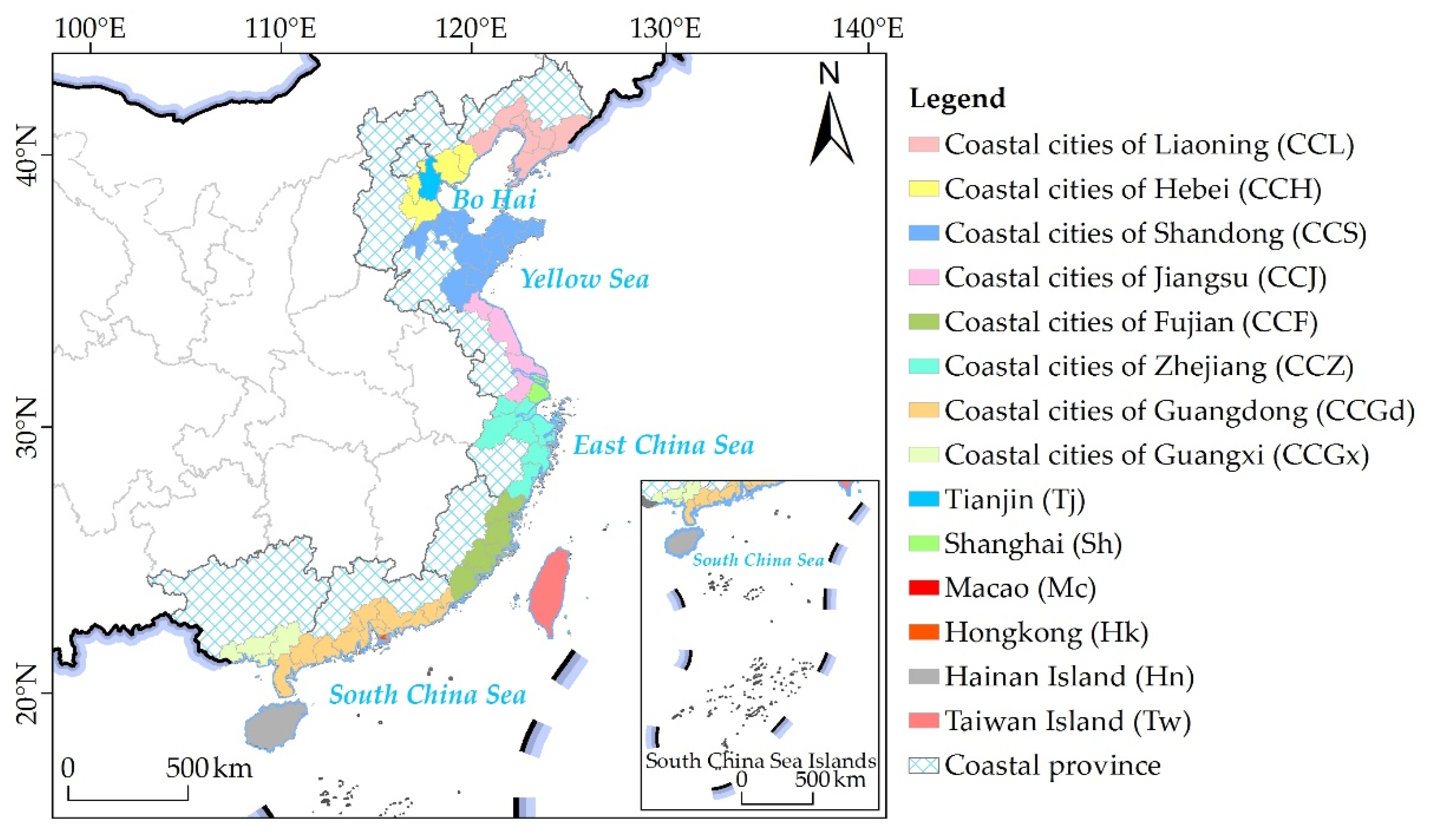

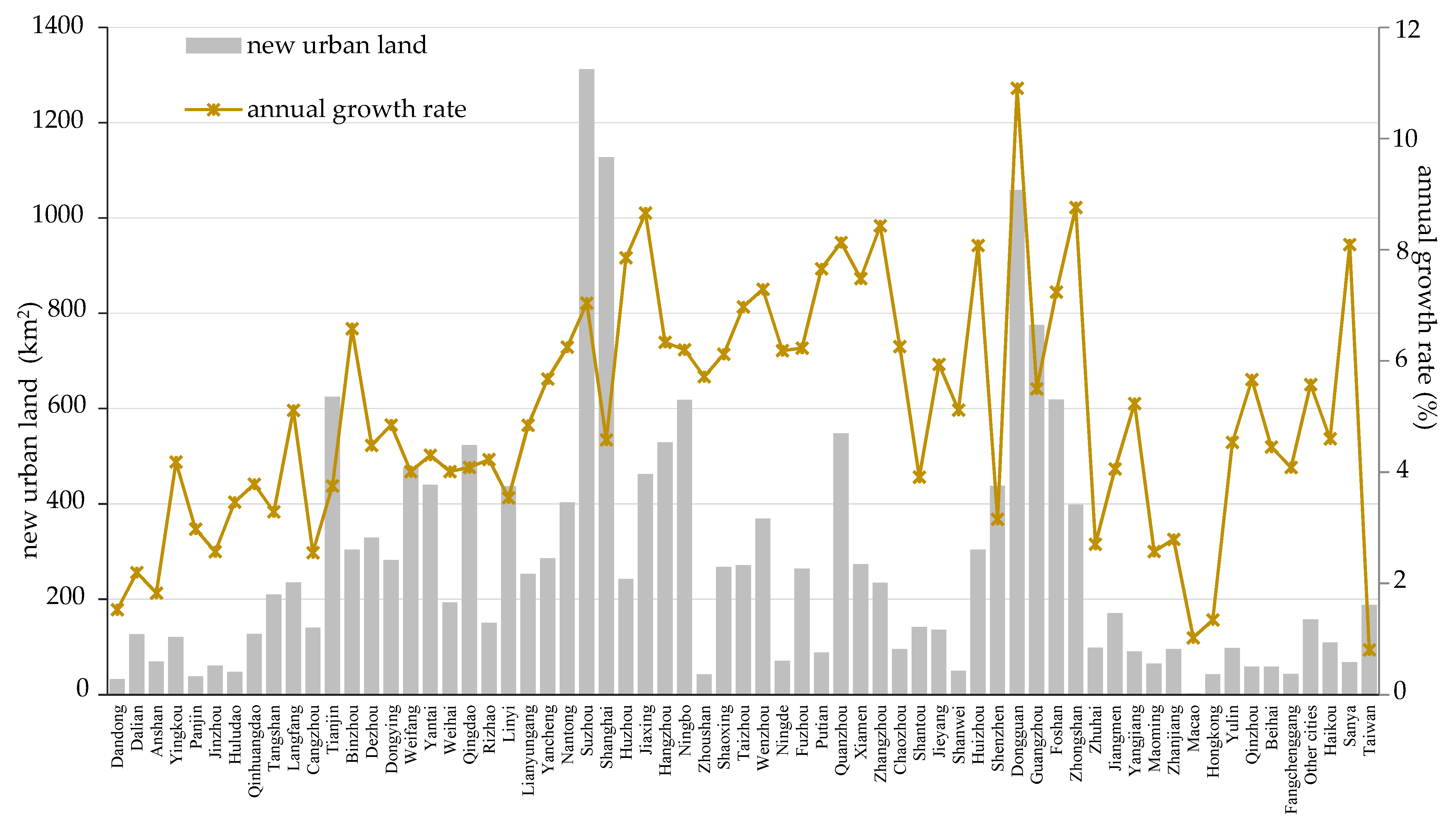
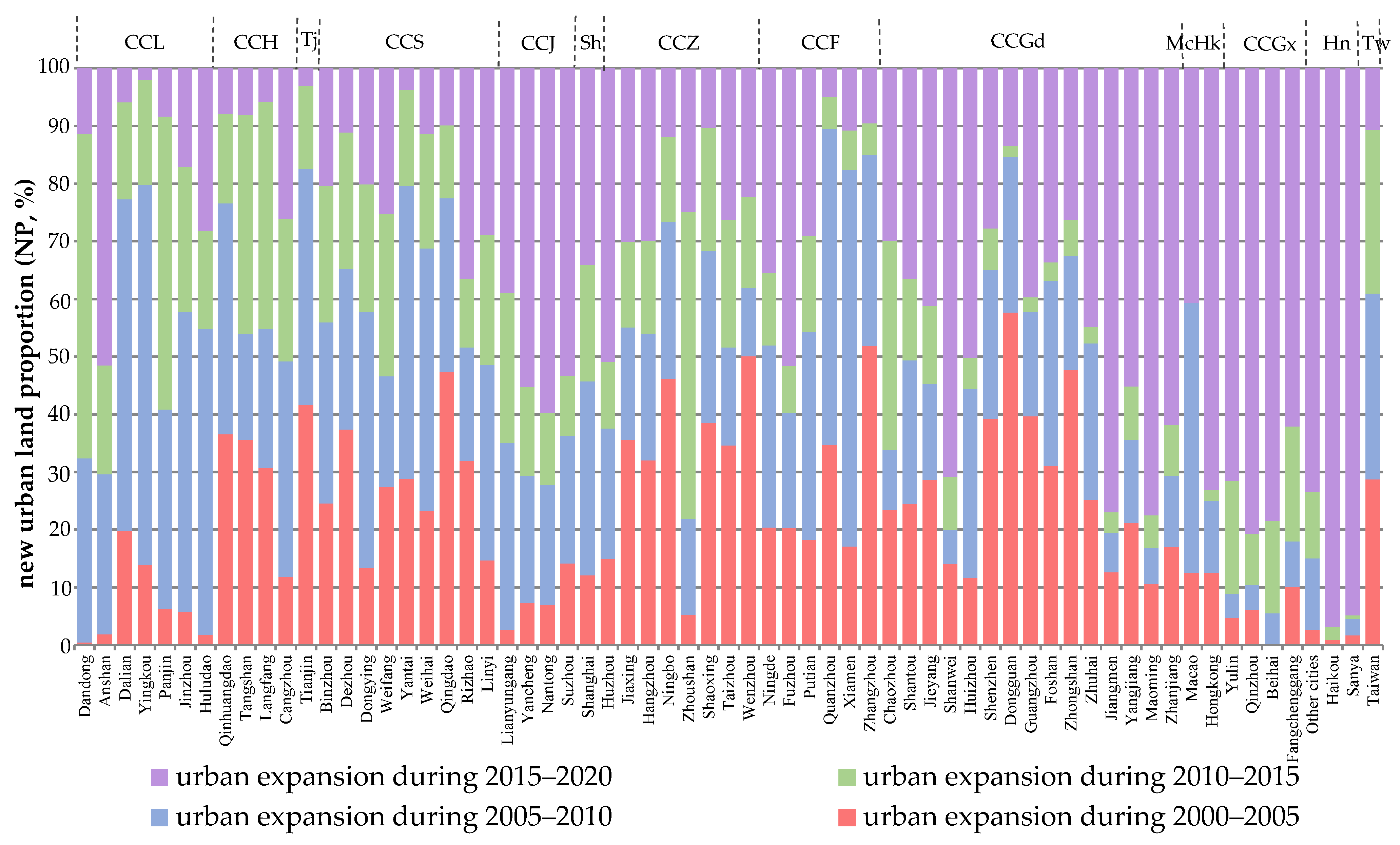
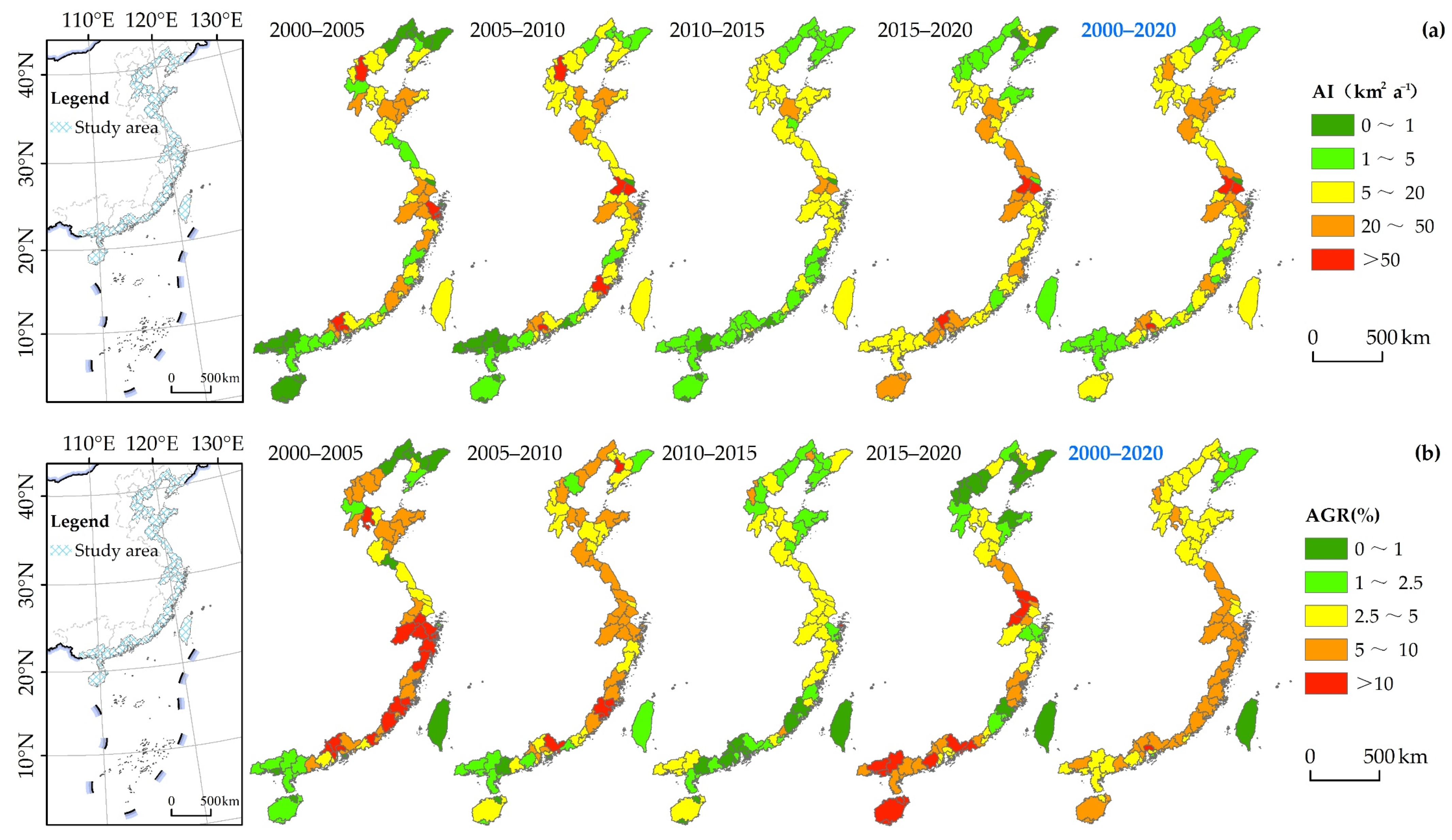
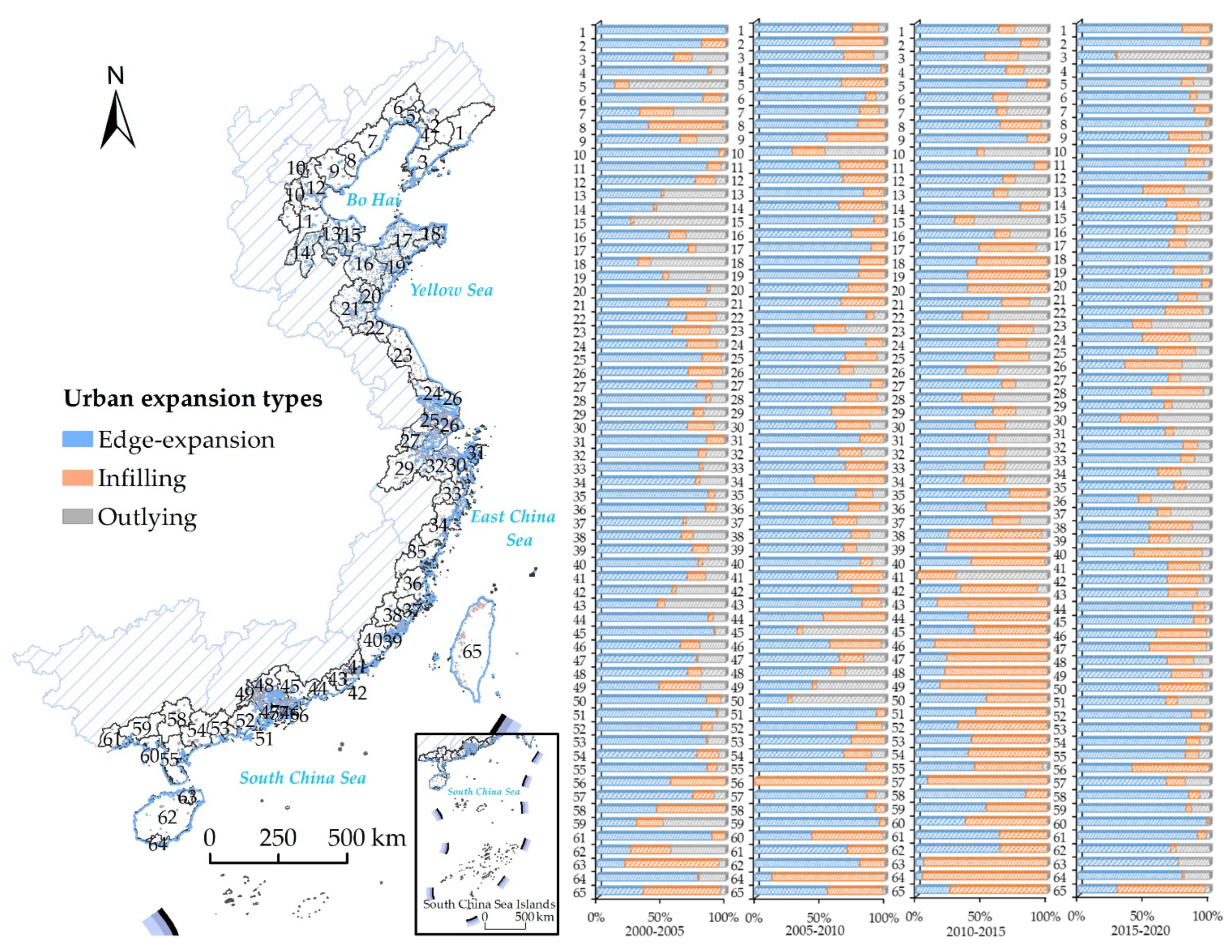
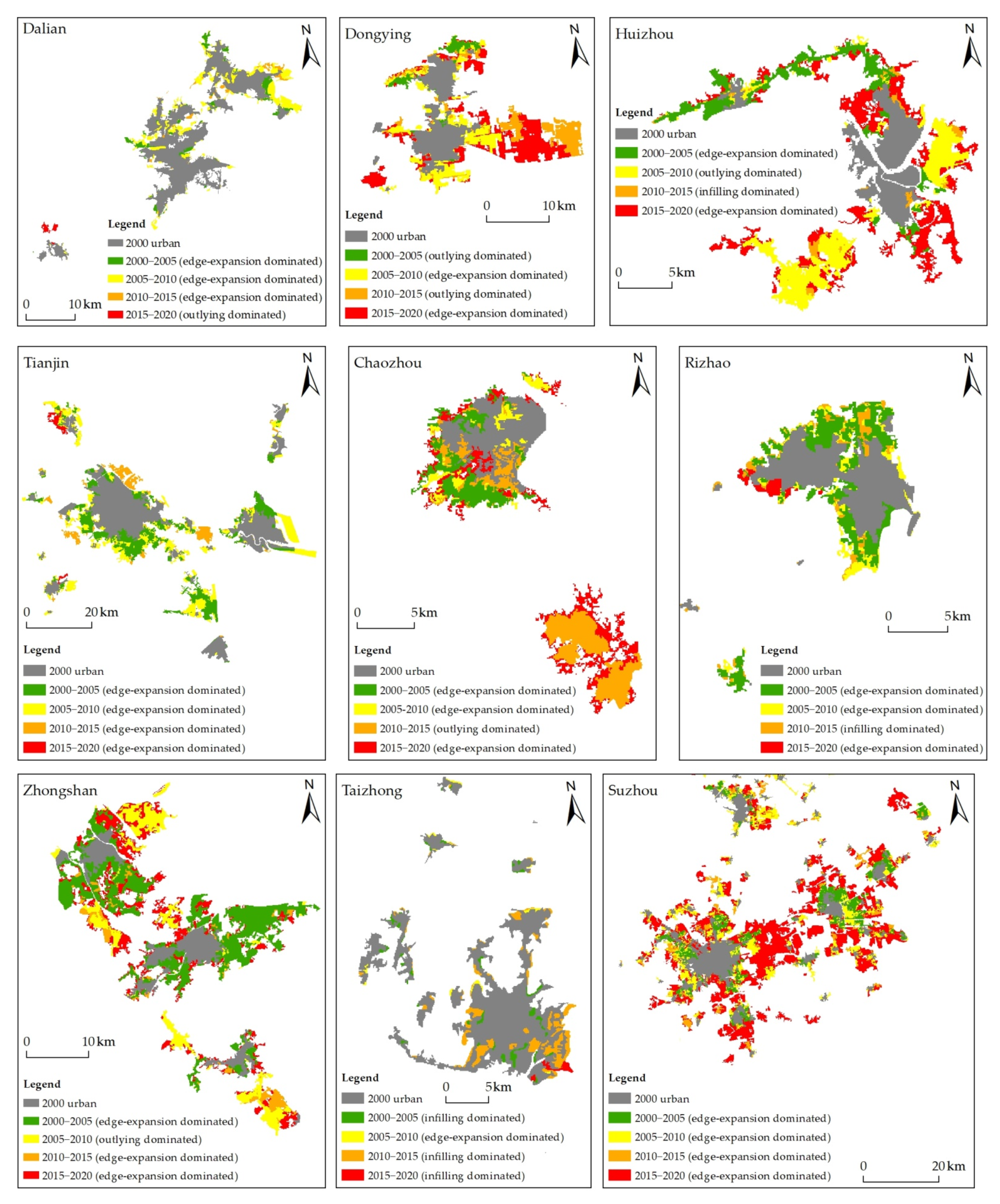
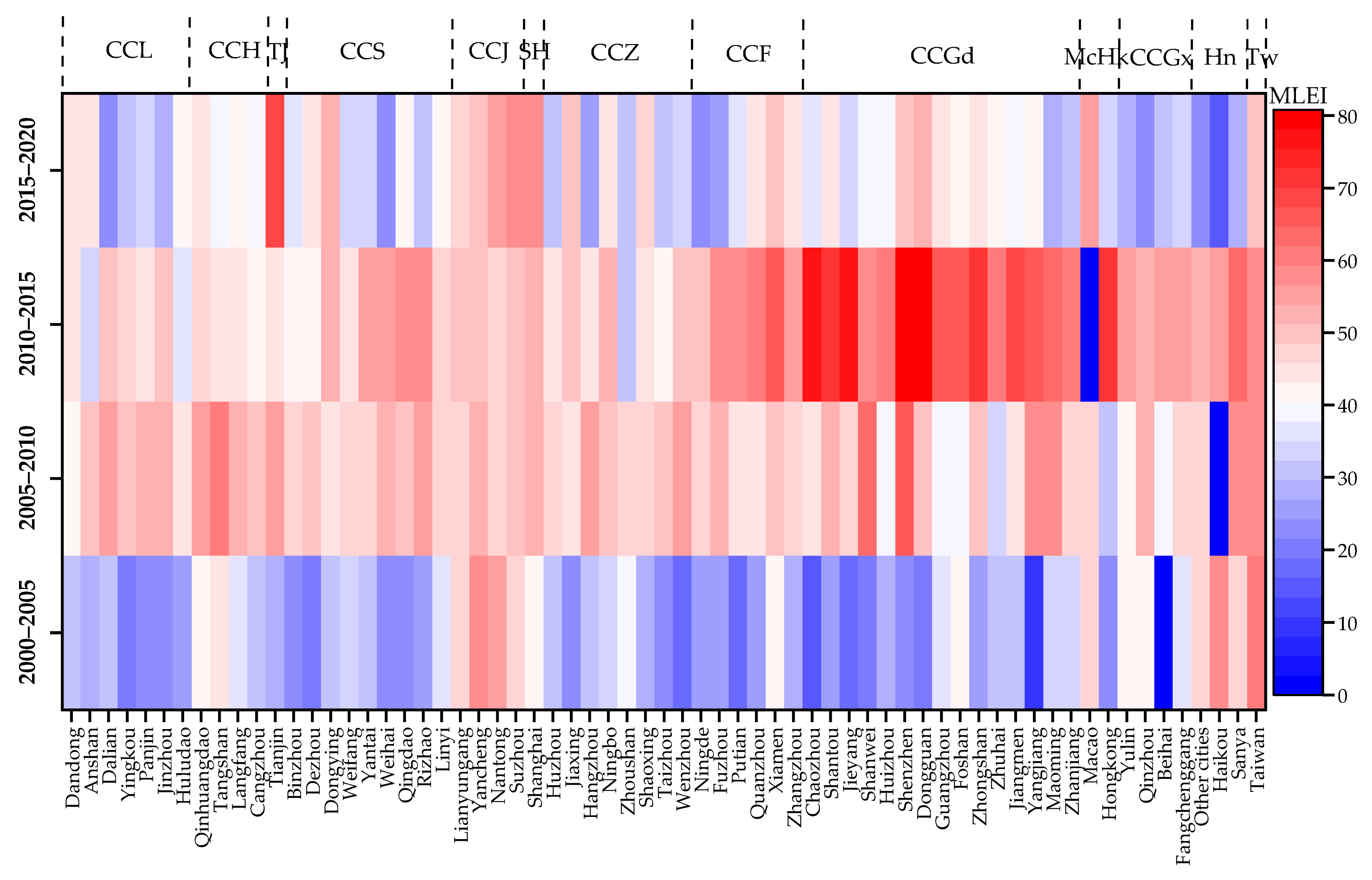
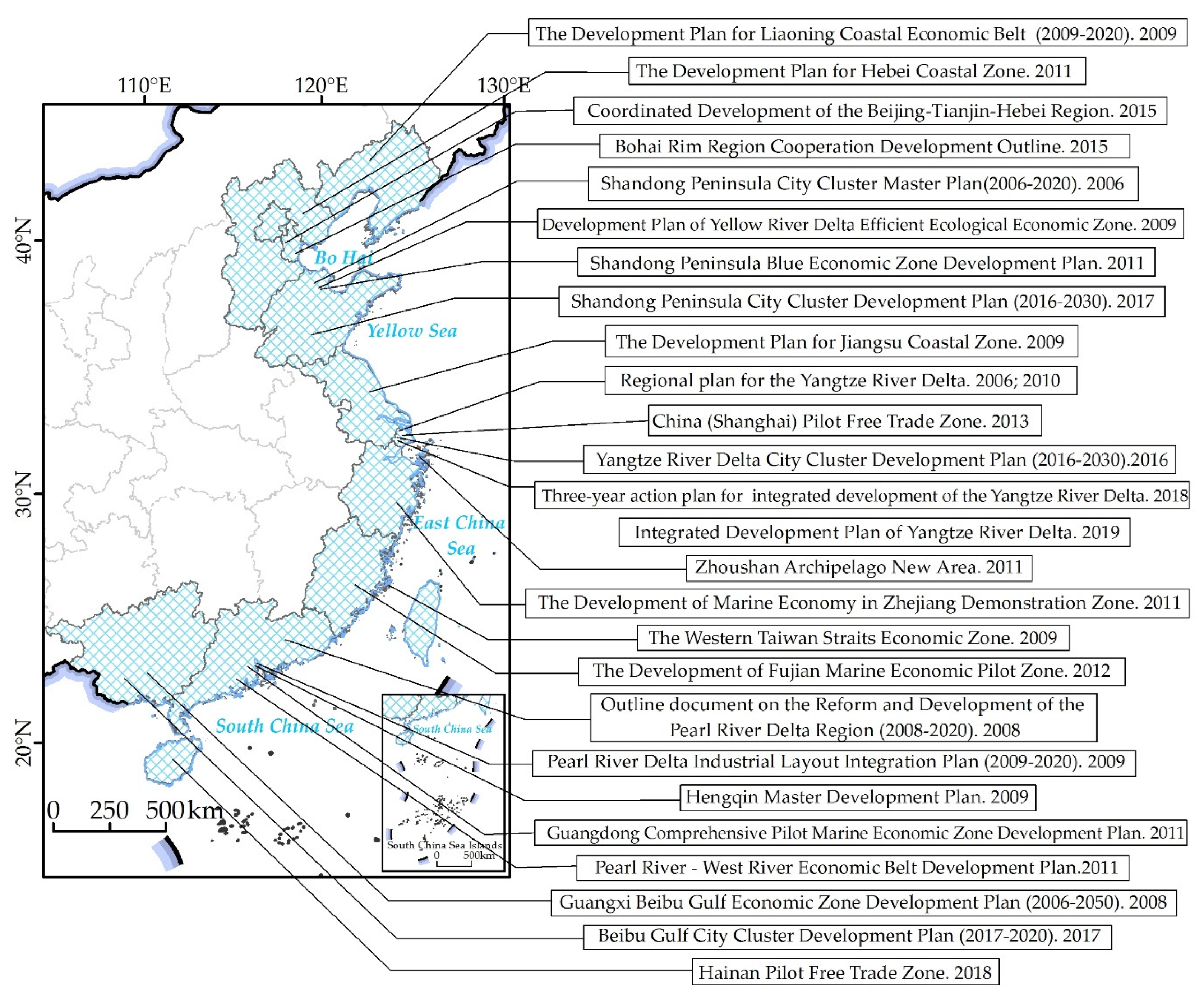
| Indicators | 2000–2005 | 2005–2010 | 2010–2015 | 2015–2020 | 2000–2020 |
|---|---|---|---|---|---|
| new urban land(km2) | 5052.35 | 5074.46 | 2533.52 | 5319.39 | 17,979.72 |
| AI (km2 a−1) | 1010.47 | 1014.89 | 506.70 | 1063.88 | 898.99 |
| AGR (%) | 7.57 | 5.50 | 2.24 | 4.06 | 4.83 |
| MLEI | 31.92 | 49.69 | 54.00 | 41.38 | 37.57 |
Publisher’s Note: MDPI stays neutral with regard to jurisdictional claims in published maps and institutional affiliations. |
© 2022 by the authors. Licensee MDPI, Basel, Switzerland. This article is an open access article distributed under the terms and conditions of the Creative Commons Attribution (CC BY) license (https://creativecommons.org/licenses/by/4.0/).
Share and Cite
Du, P.; Hou, X.; Xu, H. Dynamic Expansion of Urban Land in China’s Coastal Zone since 2000. Remote Sens. 2022, 14, 916. https://doi.org/10.3390/rs14040916
Du P, Hou X, Xu H. Dynamic Expansion of Urban Land in China’s Coastal Zone since 2000. Remote Sensing. 2022; 14(4):916. https://doi.org/10.3390/rs14040916
Chicago/Turabian StyleDu, Peipei, Xiyong Hou, and He Xu. 2022. "Dynamic Expansion of Urban Land in China’s Coastal Zone since 2000" Remote Sensing 14, no. 4: 916. https://doi.org/10.3390/rs14040916
APA StyleDu, P., Hou, X., & Xu, H. (2022). Dynamic Expansion of Urban Land in China’s Coastal Zone since 2000. Remote Sensing, 14(4), 916. https://doi.org/10.3390/rs14040916







